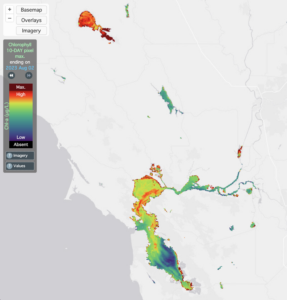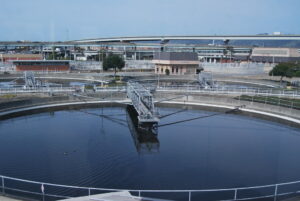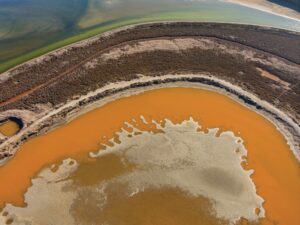It is early morning at Eden Landing Ecological Reserve and in a pond designated as E9 by the managers of the South Bay Salt Pond Restoration Project, the water is cold and still. A leopard shark, around three feet long with distinct black and brown bands and spots mottled across a steel-gray body, rests on the pond’s silty floor. There is no real agenda for the day except, of course, to eat, but for one of the largest predators in the San Francisco Bay that shouldn’t be too much of a challenge. So the shark can afford to wait for the water to warm and the tide to come in before it starts its day.
In 1855, French biologist Charles Frédéric Girard published a description of the leopard shark, coining its scientific name, Triakis semifasciata, and classifying it as a member of the Triakidae, or houndshark family. “Semifasciata” refers to the distinctive saddle markings that are the basis of this shark’s common name.
Leopard sharks are a shallow-water coastal species, with a range extending from southern Oregon to southern Baja California. They are the most abundant shark species in the San Francisco Bay, where they are generally year-round residents, though about 10 percent of the population moves out into coastal waters in the fall and winter.
Bays and sloughs are important leopard shark nursery habitats. From March through September, with a peak in April and May, female leopard sharks give birth to anywhere from 4 to 36 offspring. Leopard sharks are aplacentally viviparous, meaning females bear their young live. After a gestation period of up to 12 months, the pups emerge at 12 to 18 inches long, with their trademark pattern and fully functional teeth, ready to take on life largely on their own. They grow on average less than an inch per year and can reach a maximum length of six feet. Like all shark species, they are long-lived, mature late in life, and have a low fertility rate compared to other fish. Because of this, and in an effort to protect leopard shark populations, the California Department of Fish and Wildlife has imposed a fishing limit of three sharks per day, with a minimum length of 36 inches each. These traits of leopard sharks also make the protection of estuarine and bay habitats particularly important for their conservation.
James Hobbs, a researcher from the University of California at Davis, has stood on the levee overlooking pond E9 many times, waiting for the tide to come in, for the water to warm, and for the leopard shark — the most charismatic fish species in the Bay, he says — to wake up. Hobbs has been studying the response of fish, including leopard sharks, to the restoration of the former Cargill Salt production ponds in the South Bay. Because there is no comprehensive data available, it’s impossible to know about historic leopard shark populations in the Bay. But since the ambitious restoration project was launched in 2003 there has been a noticeable increase in the abundance of leopard sharks in the South Bay. Hobbs and his team have caught (and released) as many as 30 leopard sharks in an hour at the E9 pond, which is just one small part of the entire South Bay complex.
Beyond tracking their overall abundance, Hobbs studies what the leopard sharks are eating. He examines the contents of their stomachs using a technique called gastric lavage. Leopard sharks are not particularly aggressive, even when hands and hoses are being crammed into their small, curved mouths in the interest of science. Leopard sharks are generalists, with diets that include a variety of fish and invertebrates such as crustaceans, worms, and clams. At Eden Landing, the sharks feast on mealworms and smelt and bottom-dwelling fish called longjaw mudsuckers.
The restoration work at E9 and other former salt ponds has also created something of a leopard shark refuge. When E9 was breached in 2012, the inrushing waters created a scour hole, a deep depression in the mud. This scour hole allows the leopard sharks to stay in the pond at low tide rather than having to swim out to the deeper waters of the channel.
And these breaches have brought another benefit for the sharks: When the tide comes in, all a leopard shark has to do is swim to the nearest breach and open its mouth to feast on the prey species being swept in. When it is sufficiently full, it may retire yet again to the pond’s silty floor to wait for the next turning of the tide. Life for the South Bay’s most charismatic fish species is essentially a swim in the pond.





